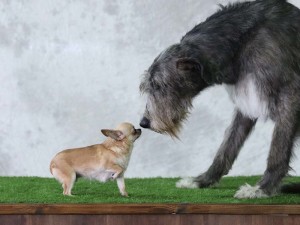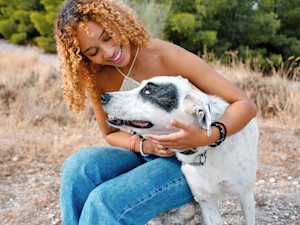Is My Dog Self-Aware? How to Measure Their Levels of Awareness
They notice more than you think.

Share Article
At some point, most of us wonder what’s going on in our dogs’ heads. Whether triggered by displays of surprising intelligence or boneheadedness, questions about dogs’ perception of themselves and the world around them have intrigued pet parents, behaviorists, psychologists, and philosophers. We often seek to understand if dogs experience life in the same way we do, but it is only recently that testing of dogs’ awareness has acknowledged that they interact with the world in their own way.
Main takeaways
Dogs show many forms of self-awareness under numerous testing conditions.
Dogs form significant attachment bonds with their parents. These bonds lead to displays of empathetic behavior.
Although dogs haven’t passed the mirror self-recognition test, this test may be a flawed way of assessing if dogs are self-aware.
Dogs are aware of their own scent and understand when it has been altered.
Are dogs self-aware?
For many years, researchers assumed that dogs were not self-aware because they didn’t seem to recognize their image in the mirror as their own. More recent research has shown that dogs are more aware of themselves than previously thought.
Self-awareness has many manifestations. Some of the more philosophical ones can’t easily be tested. In humans, part of self-awareness involves considering our behavior and evaluating if we are upholding our standards and values. This seems like a lot for a dog, so the dog version of this might be: does a dog worry if they’re a good dog? That idea is very hard to test.

Another version of self-awareness is self-recognition. Do dogs maintain a mental representation of their body and the space it occupies? That may be a bit easier to find out.
Body awareness
Tests have consistently shown that dogs are aware of the physical space they occupy. This means both that they recognize the size of their body and that they realize that their body affects the world around them.
Across numerous tests, dogs consistently show that they are aware of whether they can fit through an opening and will take a longer path to a reward if they feel they can’t fit. This type of body awareness is a key component of self-recognition and shows that dogs can likely form an image of themselves in their mind.
Another test wanted to find out if dogs realized that their body could be an obstacle. Dogs were trained to bring an object to their parents on command. This object was then either attached to a mat that the dog would stand on while picking the object up or to the solid ground beneath the mat. Dogs showed awareness that their body was preventing them from retrieving the object when it was attached to the mat and moved so that they weren’t standing on the mat. This movement occurred less frequently when the object was attached to the ground. This shows that dogs are aware of how their body impacts things around them.
Scent awareness
Dogs seem to be aware that a certain smell belongs to them and generally show less interest in exploring their own scent. This makes sense when you consider that dogs use scent information to mark territory. Dogs recognize their own scent markings and don’t pay much attention to them, instead focusing on foreign scents that can tell them about who else has been in their area.
Capability awareness
Dogs do seem to have some awareness of their physical capabilities. They may sometimes test these boundaries and fail, but that doesn’t necessarily mean that they don’t consider them. Most pet parents have seen a demonstration of this: given time to think about it, dogs will consider if they can make a jump before attempting it.
Awareness of reflection
Do dogs know their reflection? Classic research says they do not, but it’s possible the testing methodology is flawed (more on this later). Despite not seeming to acknowledge that they are the dog in the mirror, dogs are aware of how reflections in mirrors work. Dogs have used mirrors to monitor where an object is hidden, then found the object more quickly than dogs that were not able to watch where it was placed.
Awareness of others
Dogs are inherently social animals and have a distinct awareness of other dogs, animals, and people. They show the ability to react to both human and animal social cues, and they can learn behaviors and actions from their parents and playmates.
Do dogs understand pet-parent relationships?
Sometimes it can feel like your dog just uses you as a food delivery service, and it wouldn’t matter what human was around as long as they fill the bowl up on time. Despite our occasional misgivings about their behavior, dogs do seem to form an emotional attachment to the people most familiar to them.
Attachment bonds
Dogs form significant attachment to their parents, showing changes in behavior during separation, participating in greeting rituals during reunions, and seeking the presence of a familiar person during times of stress. The attachment styles seen between a dog and their favorite person mirror those between a young child and their parent.
Emotional recognition
Dogs are able to pick up on people’s emotional states. In tests, dogs can recognize sounds of crying and distress from humans they are separated from and show more urgency in reaching them when they seem upset. In addition, dogs show more empathy for people in distress if they are familiar with them. This means your dog actually does care more about you than a stranger.
Social structures
Social hierarchy is important to dogs, and they recognize the importance of social structures in relation to both other dogs and people. Dogs take cues from familiar humans and watch them for instructions. They can complete tasks after someone shows them how to do them and will even imitate the way a task is accomplished, even if it is done in a purposefully inefficient way. This type of imitation is seen in closely bonded people, but not in many other animal species like great apes.
Separation anxiety
Some dogs get unreasonably anxious when separated from people they are closely bonded to. Separation anxiety can lead to increasing stress, self-harm, and destructive behavior. Separation anxiety is a complex topic, but dogs seem to do best when they are confident their parents will return and can rely on them to behave predictably.
How to test a dog’s awareness: The mirror test
The mirror self-recognition (MSR) test was developed in the 1970s to determine if animals realized that the reflection in the mirror was their own. In the most common version of the test, a mark is placed on a body part while the animal is unaware. The animal is then observed to see if they touch the area more before and after a mirror is introduced to their enclosure. While some species like the great apes, dolphins, and orcas have passed the test, most other species fail to show that they recognize that they see themselves in the mirror.
So, why don’t dogs recognize themselves in the mirror? After all, it seems obvious to many pet parents that their dogs are aware that the dog in the reflection is not another dog (otherwise we’d have a lot of broken mirrors around). It’s possible that the mirror test is too human-centric. People generally rely on vision as our primary way of exploring and guiding our interactions with the environment. Dogs prioritize scent over vision, so a mirror test using changes in their scent was developed.
Dogs participating in the “olfactory mirror” test spent more time investigating their altered scent than their unaltered scent or the altering agent alone. The validity and relevance of this experiment is still being debated, but it shows further evidence that dogs are self-aware.
Final thoughts
Gauging animal intelligence and cognition is a challenging endeavor, and tests like the olfactory mirror show that researchers need to find approaches that test what is important to the animal being tested, not to humans. When tested, dogs seem to be self-aware in many ways, and the areas where they fail may be due to flaws with the testing method rather than their intelligence. After all, dog scientists would probably think most humans were pretty dumb if they tested our ability to track scents or know when an earthquake is coming.
References
Arden, Rosalind, et al. “A Review of Cognitive Abilities in Dogs, 1911 through 2016.” Current Directions in Psychological Science, vol. 25, no. 5, Oct. 2016, pp. 307–312, https://doi.org/10.1177/0963721416667718opens in new tab.
Bastos, Amalia P. M., et al. “Dogs Mentally Represent Jealousy-Inducing Social Interactions.” Psychological Science, vol. 32, no. 5, 7 Apr. 2021, pp. 646–654, https://doi.org/10.1177/0956797620979149opens in new tab.
Cazzolla Gatti, Roberto. “Self-Consciousness: Beyond the Looking-Glass and What Dogs Found There.” Ethology Ecology & Evolution, vol. 28, no. 2, 13 Nov. 2015, pp. 1–9, https://doi.org/10.1080/03949370.2015.1102777opens in new tab.
Gallup, Gordon G., and James R. Anderson. “The “Olfactory Mirror” and Other Recent Attempts to Demonstrate Self-Recognition in Non-Primate Species.” Behavioural Processes, vol. 148, Mar. 2018, pp. 16–19, https://doi.org/10.1016/j.beproc.2017.12.010opens in new tab. Accessed 4 Apr. 2020.
Howell, Tiffani J., et al. “Do Dogs Use a Mirror to Find Hidden Food?” Journal of Veterinary Behavior, vol. 8, no. 6, Nov. 2013, pp. 425–430, https://doi.org/10.1016/j.jveb.2013.07.002opens in new tab. Accessed 24 Nov. 2020.
Huber, Ludwig, et al. “Would Dogs Copy Irrelevant Actions from Their Human Caregiver?” Learning & Behavior, vol. 46, no. 4, 6 July 2018, pp. 387–397, https://doi.org/10.3758/s13420-018-0336-zopens in new tab.
Konok, V., et al. “Attachment Styles in Dogs and Their Relationship with Separation-Related Disorder – a Questionnaire Based Clustering.” Applied Animal Behaviour Science, vol. 213, Apr. 2019, pp. 81–90, https://doi.org/10.1016/j.applanim.2019.02.014opens in new tab. Accessed 7 Nov. 2020.
Konok, Veronika, et al. “Influence of Owners’ Attachment Style and Personality on Their Dogs’ (Canis Familiaris) Separation-Related Disorder.” PLOS ONE, vol. 10, no. 2, 23 Feb. 2015, p. e0118375, https://doi.org/10.1371/journal.pone.0118375opens in new tab.
Lea, Stephen E. G., and Britta Osthaus. “In What Sense Are Dogs Special? Canine Cognition in Comparative Context.” Learning & Behavior, vol. 46, no. 4, 24 Sept. 2018, pp. 335–363, https://doi.org/10.3758/s13420-018-0349-7opens in new tab.
Lenkei, Rita, et al. “Dogs (Canis Familiaris) Recognize Their Own Body as a Physical Obstacle.” Scientific Reports, vol. 11, no. 1, 18 Feb. 2021, https://doi.org/10.1038/s41598-021-82309-xopens in new tab.
Lenkei, R., et al. “That Dog Won’t Fit: Body Size Awareness in Dogs.” Animal Cognition, vol. 23, no. 2, 12 Dec. 2019, pp. 337–350, https://doi.org/10.1007/s10071-019-01337-3opens in new tab.
Payne, Elyssa, et al. “Current Perspectives on Attachment and Bonding in the Dog–Human Dyad.” Psychology Research and Behavior Management, vol. 8, Feb. 2015, p. 71, www.ncbi.nlm.nih.gov/pmc/articles/PMC4348122/opens in new tab, https://doi.org/10.2147/prbm.s74972opens in new tab.
Pongrácz, Péter, et al. “Body Size Awareness Matters When Dogs Decide Whether to Detour an Obstacle or Opt for a Shortcut.” Scientific Reports, vol. 13, no. 1, 19 Oct. 2023, p. 17899, www.nature.com/articles/s41598-023-45241-wopens in new tab, https://doi.org/10.1038/s41598-023-45241-wopens in new tab.
Reiss, Diana, and Rachel Morrison. “Reflecting on Mirror Self-Recognition: A Comparative View.” American Psychological Association EBooks, 1 Jan. 2017, pp. 745–763, https://doi.org/10.1037/0000012-033opens in new tab. Accessed 10 Feb. 2024.
Rivera, Micael M, and Julia E Meyers-Manor. “Beware of Strangers: Dogs’ Empathetic Response to Unknown Humans.” Animals, vol. 14, no. 14, 22 July 2024, pp. 2130–2130, https://doi.org/10.3390/ani14142130opens in new tab.
Sanford, Emily M., et al. “Timmy’s in the Well: Empathy and Prosocial Helping in Dogs.” Learning & Behavior, vol. 46, no. 4, 23 July 2018, pp. 374–386, https://doi.org/10.3758/s13420-018-0332-3opens in new tab.

Dr. Bartley Harrison, DVM
Dr. Bartley Harrison is a veterinarian with more than 19 years of experience. He has treated a variety of species in emergency and speciality practices for both large and small animals. His primary interests as a vet are emergency medicine and critical care.
Related articles
![Brown, half breed dog sitting on a chair next to his owner, a blonde stylish woman wearing a brown smart suit.]()
Your Dog Can Read Your Mind, Kind Of
Researchers say dogs actually have a pretty good sense of what we’re thinking.
![curly haired dog waiting in a window for their owner]()
How Do Dogs Know That You Are Coming Home?
Your dog’s keen sense of smell isn’t the only clue.
Can Dogs Feel Guilt?
They do look very sorry...
Are Dogs Color Blind? How Do We Know What Colors Dogs Can See?
It’s not all black and white.
Dog Senses: What Are Dogs’ Strongest Senses?
That little nose sure works well...
![Woman hugging her dog outside.]()
Your Dog Can Understand Your Facial Expressions, Study Says
And they love it when you smile.








